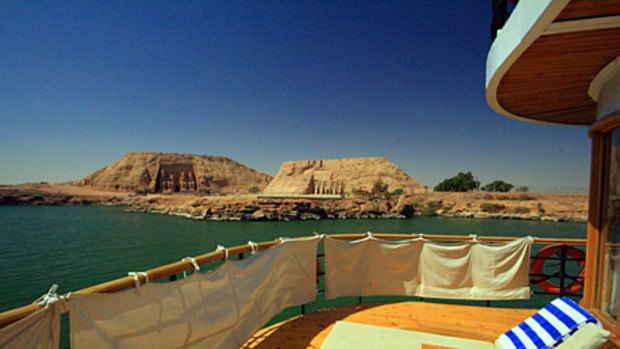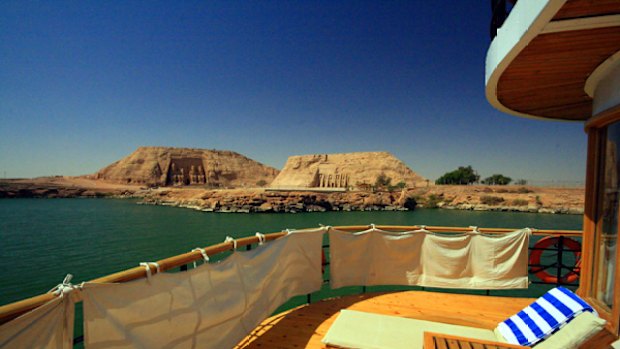
Abu Simbel, Egypt.Credit: Belinda Jackson
Cruising Lake Nasser to Abu Simbel is temple heaven, writes Belinda Jackson.
If you were asked how you'd like to spend a year of your 20s when you're fit, strong and virile, you probably wouldn't choose a drowned Nubian desert with no women, no shops, late-night cafes and definitely no all-night rave clubs. Unfortunately for the young Egyptian guy standing in front of me, that's exactly the hand he's been dealt.
He's stuck here in southern Egypt, serving his compulsory military service in a grubby might-have-been-white uniform as part of the police presence at the historical temple complex of Wadi el-Seboua.
We get excited spotting him as he's one of the few people we see from our cruiser, the MS Kasr Ibrim, as we coast from Aswan to Abu Simbel on the silent waters of Lake Nasser, just north of the Sudanese border.
"No photos, no photos!" he shouts as we attempt to snap the first living thing we've seen all day.
But every time he senses a camera, he avoids eye contact and assumes a suspiciously practised pose, gazing out to the water, gun at the ready.

Tall order ... the deck of the MS Kasr Ibrim.Credit: Belinda Jackson
These temple sites are serious one-donkey affairs and accessible only by boat. "In 2009, the lake is considered isolated but in 1300BC, when the Pharaoh Ramses II built these temples, this would have been considered the end of the Earth," our guide, Safi, says, waggling a long finger. For the policeman, it still is. Aside from travellers in a few luxury cruisers, the only people the young copper sees are the temple guards from the Egyptian Department of Antiquities and some fishermen who double as camel-tour touts.
There's just the temple and the lake. For him it's hell but for us spoilt few, it's two flights downstairs from heaven.
Lake Nasser is the world's largest artificial lake and is often described as one of the great engineering feats, a statement that, unless you're an engineer, just makes you want to nod off.
It's not until you're on the lake – and concurrently in the midst of the desert – that it sinks in. Lake Nasser is more than 500 kilometres long and up to 30 kilometres wide. Unlike the Lower Nile cruises between Aswan and Luxor, you can barely see the coastline. And what you can see is desert, sans oases. No lush palms, little villages or happy farming scenes.
Occasionally, we spot a tiny shack for fishermen chasing balti and the monstrous Nile perch that can grow to more than 180 centimetres long and tip the scales past 170 kilograms.
Of the handful of cruisers operating on Lake Nasser, our boat, a 1920s art deco extravaganza named after a ruined Nubian fortress, is the best known. Instead of a single cabin with a porthole the size of a pigeon's eye, I've landed a suite with a wraparound sundeck and walls of walnut veneer. There are a few old-fashioned touches, like the built-in radio near the bedhead and the paper hygiene strip wrapped around the toilet a la the Miss Congeniality sash on a beauty queen.
The Kasr Ibrim is usually 60:40 French to Brits, though this time the French have well and truly won and there are but nine native English speakers on board. We're a small, energetic group, me and the Brits in their 50s and 60s, and are raring to go with Safi, our own hip, lanky guide.
While still moored in Aswan, we take a little boat out to the Temple of Kalabsha, set on a sometimes-island in the lake. We take in the nitty-gritty of the carvings – sure there's Horus, Isis and all the ancient godly gang but also reliefs of macho Ramses II giving some Nubian soldiers a good hiding, receiving an exotic procession of people bearing leopard skins, shields, fox furs, monkeys, cheetahs and giraffes and, as a full-grown man, being breastfed by goddesses; cue for naughty snickering and talk of Oedipal complexes.
The next morning we set sail, navigating the original channel of the River Nile. Looking over the pilot's shoulder, I see dark spots on the radar, a drowned landscape submerged in up to 180 metres of water.
We clink glasses as we cross the Tropic of Cancer and stop to explore the temples of Dakka, Amada, Derr and the ancient tomb of Penout, where a bloke wearing a dusty jellabiya waggles a baby crocodile at me. "Five pounds for a photo," he mutters as I pass.
It might be just a few weeks old but already the Nile crocodile has the 1000-yard stare of a born killer. They're famously bad-tempered and famously shy of humans (despite having a taste for us) and we spot a grown-up croc languishing on a muddy riverbank giving a few flamingos the eye before sliding into the waters. In their heyday, the temples along the lake's shores were part of the lands of Nubia, one of those ephemeral concepts of a country where a distinct ethnic group's traditional lands have been swallowed by surrounding countries or, in this case, a lake.
Poor Nubians – they've been beaten by both ends of the stick. Their heritage was first lost to the shifting desert sands, then rediscovered in the early 1800s when a Swiss explorer stumbled upon Abu Simbel, only to be lost once again, along with their villages, to the rising waters of the dammed Nile in the 1970s. It gives a whole new meaning to being between a rock and a hard place.
The government relocated the 800,000-odd villagers, paying them a small compensation, and when the global village realised the proposed Aswan High Dam, built between 1958 and 1971, would also immerse a swag of significant temples, 54 countries rushed in to perform heroic piece-by-piece removals and reconstructions, including the piece de resistance, the relocation of Abu Simbel.
After three days' easy sailing, we arrive at Abu Simbel, the jewel of Nubia, bang on lunchtime. Our cruiser prowls the waters in front of the temples for a rare view of the 13th-century BC temple, with the megalomaniacal tribute to Ramses II – four 20-metre colossi demanding the attention of our cameras. Forget schlepping through the temple in the heat of the day with the hundreds of tourists who've flown down or travelled from Aswan in a convoy of buses, though; later, once the weather cools and the other tourists have gone home, we'll disembark to explore the temples in relative peace. But for now, we will take lunch with kings and gods.
During the relocation, the temple was sliced into 830 blocks and moved up and away from the lake. Only the faces remained uncut.
The temple was even reconstructed so the sun still falls on Ramses's face twice a year, on his birthday and his ascension to the throne, as per the original design.
Essentially, Abu Simbel was an enormous public-relations exercise – those entering the kingdom from the south via the Nile would be reminded of the greatness of that land's ruler by being confronted by massive statues of Ramses. Word has it he was a bit of a cuckoo, stealing earlier kings' victories by slapping his cartouche everywhere, talking himself up as ruler of the world. Seems he was more a lover than a fighter, fathering almost 100 children.
Beside the great temple of Ramses II is the smaller temple of the mother-goddess Hathor, built for Ramses's beloved and beautiful wife, Nefertiti. Inside her temple are massive reliefs of the battle of Qadesh in 1275BC, where Ramses shows off, sticking it to the Hittites in a classic case of: "Look at me, Nefertiti!"
Officially, you can't take photos inside the temple but for an idea of scale, thousands of tourists are snapped beside Ramses's seated statues at the front of the temple. Little ants, we barely reach the top of his great toes.
We stay at the temples until dusk, then take a seat at his feet for the sound and light show.
"Son of the sun, king of eternal time," begins the stentorian voice of the storyteller in the darkness.
Clouds of light race across the night sky to grow stronger until they illuminate the temples of Abu Simbel. Lover, fighter, builder, glory hound: Ramses II is showing nightly, proof that fame is the elixir of eternal youth.
The writer was a guest of Soleils d'Egypte and Etihad Airways.
GETTING THERE
Etihad Airways flies from Sydney and Melbourne to Cairo via Abu Dhabi. Phone 1800 998 995, see etihadairways.com. EgyptAir flies Cairo-Aswan-Abu Simbel.
SIGHTSEEING
MS Kasr Ibrim sails every Saturday from Aswan to Abu Simbel for four nights-five days and every Wednesday from Abu Simbel for three nights-four days. Winter berths (October-April) are priced from €173 ($278) a person, a night, twin share. Includes all meals, a guide and entrance to all sights. Book through Soleils d'Egypte, phone +202 2644 0150, email contact@soleilsdegypte.com, or Nemonic Concepts, phone (02) 9526 8519, see nemonic.com.au. Also see kasribrim.com.eg.
The Abu Simbel Sound and Light Show takes about 35 minutes, see soundandlight.com.eg.
FURTHER INFORMATION
See egypt.travel.
Sign up for the Traveller Deals newsletter
Get exclusive travel deals delivered straight to your inbox. Sign up now.